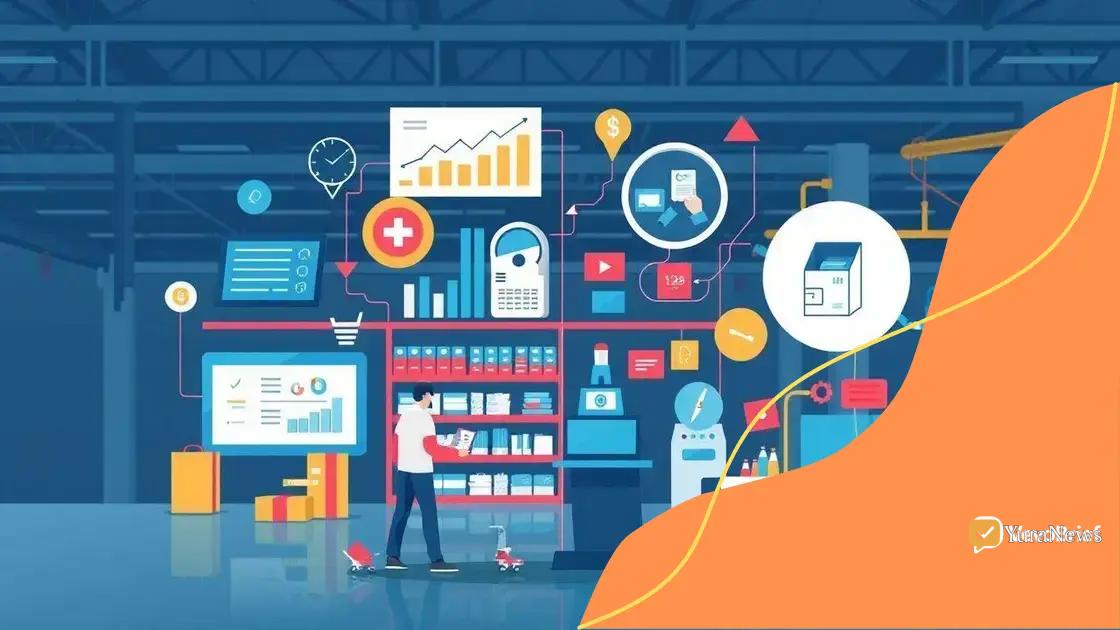Economic growth forecasts revised downwards: what it means for us

Anúncios
Economic growth forecasts have been revised downwards due to rising inflation, geopolitical tensions, and the impact of supply chain disruptions, prompting businesses to adapt strategies to navigate these uncertainties.
Economic growth forecasts revised downwards may sound alarming, but what does it truly imply for our day-to-day lives? With the world facing various challenges, understanding these revisions can help us navigate our finances and future better.
Anúncios
Current state of global economic forecasts
The current state of global economic forecasts reveals a landscape filled with uncertainty and shifts. Recently, economists have adjusted their predictions, taking into account various factors shaping the market today.
Reasons for Forecast Changes
As analysts review the data, several key reasons emerge. Global events, policy changes, and unexpected economic indicators can rapidly alter forecasts. Understanding these reasons helps individuals and businesses prepare.
- Inflation trends affecting consumer spending
- Supply chain disruptions causing delays
- Geopolitical tensions influencing trade
- Technological advancements reshaping industry
Moreover, these changes are not uniform across all countries. Some economies may show resilience, while others struggle to keep pace. For example, emerging markets may experience different effects compared to established economies.
Anúncios
Impact on Different Sectors
The revisions in economic forecasts profoundly impact various sectors. Understanding how businesses can adapt is crucial in this environment. The technology sector often leads with innovation, while others may face challenges. Sectors like tourism and traditional retail could see major fluctuations.
It’s essential to monitor these forecasts closely. While some may view them negatively, opportunities can arise amidst challenges. Many businesses are exploring cost-effective strategies to navigate through these uncertain times. Keeping an eye on the global economy can spark new ideas and approaches.
Factors leading to downward revisions
Several factors leading to downward revisions of economic forecasts have become prominent in recent discussions among economists. Recognizing these factors can help businesses and individuals plan better and adapt to changing circumstances.
Economic Indicators
Many economists use various indicators to assess the health of the economy. However, when these indicators show a decline, it prompts revisions to earlier forecasts. Key indicators include unemployment rates, inflation rates, and GDP growth. For instance, rising inflation can erode purchasing power, affecting consumer behavior and overall demand.
- Unemployment rises leading to decreased consumer spending
- Higher inflation results in increased costs for businesses
- Slower GDP growth signals potential economic stagnation
- Interest rate changes affect borrowing and investments
Furthermore, external factors play a significant role. Global events, such as geopolitical tensions or health emergencies, can disrupt markets and alter consumer confidence. When uncertainty looms, businesses might hesitate to invest, prompting economists to lower their forecasts.
Supply Chain Disruptions
Supply chain issues have been especially impactful. Delays in getting materials or products can hinder production capacity, leading to decreased output and sales. These disruptions can result from various challenges, including natural disasters or trade disputes. When companies face obstacles like these, the resultant effects ripple through the economy, causing overall forecasts to shift downward.
Additionally, technological advancements can create new challenges. While innovation often brings growth, it can also lead to market volatility. Industries may have to adapt quickly, sometimes outpacing existing economic models, leading to uncertain forecasts.
Sector-specific impacts of revised forecasts

The sector-specific impacts of revised forecasts can vary significantly across different industries. Understanding how each sector is affected allows businesses and investors to make more informed decisions. The consequences of economic revisions are not uniform; they depend on the unique characteristics of each industry.
Technology Sector
In the technology sector, revised forecasts often lead to quicker adaptations. Companies may shift strategies, focusing on innovation and development to stay competitive. As economic uncertainty increases, tech firms might also streamline their operations to reduce costs, balancing their growth with caution.
- Increased investment in research and development
- Potential delays in product launches due to market conditions
- Shifts in consumer demand impacting software and hardware
- Heightened focus on cybersecurity to protect assets
Moreover, this sector tends to be more resilient in downturns. The demand for digital solutions, remote work tools, and cloud services can drive growth even during economic slumps.
Retail Sector
The retail sector often experiences immediate effects from revised forecasts. When forecasts suggest a decline in consumer spending, retailers may implement discounts and promotions to attract customers. This sector is particularly sensitive to changes in consumer confidence and purchasing power, leading to strategic adjustments.
Changing consumer preferences also play a role. For example, shifts towards online shopping have accelerated, changing how retailers operate. Retailers now focus more on e-commerce platforms, enhancing user experiences and optimizing delivery services to meet evolving demands.
While some retailers struggle during economic downturns, others adapt by enhancing their online presence or diversifying product offerings. These changes can help mitigate some of the negative effects stemming from revised economic forecasts.
Manufacturing Sector
The manufacturing sector faces unique challenges when forecasts are revised downward. Lower demand for goods can lead to production cuts and reduced workforce hours. However, this sector’s ability to adapt often depends on its supply chain resilience and capacity to innovate.
Manufacturers may seek efficiency improvements and invest in automation technologies to reduce costs. This approach not only minimizes the impacts of downward revisions but also sets the stage for future growth as the economy recovers.
Strategies for businesses amid economic uncertainty
In times of economic uncertainty, businesses must adopt effective strategies to navigate challenges. Understanding these strategies can help organizations remain resilient and competitive, even when forecasts are less favorable.
Diversifying Revenue Streams
One key strategy is to diversify revenue streams. Relying on a single income source can be risky, especially during downturns. By expanding into new markets or offering additional products and services, businesses can reduce their risk.
- Explore new market segments to reach more customers
- Develop complementary products that enhance existing offerings
- Consider partnerships or collaborations to broaden reach
- Utilize online platforms for e-commerce growth
By diversifying, companies can create a buffer against economic fluctuations. This approach allows them to seize new opportunities and adapt more easily in changing landscapes.
Enhancing Operational Efficiency
Another effective strategy is enhancing operational efficiency. When resources are limited, businesses must find ways to do more with less. Improving processes can save time and money, ultimately driving profitability.
Implementing technology can play a vital role. Automation tools and software solutions can streamline operations, reduce manual effort, and improve accuracy. Regularly reviewing workflows helps in identifying areas for improvement, leading to better resource allocation.
Investing in employee training can also enhance efficiency. A skilled workforce is more adaptable and innovative, capable of responding quickly to market changes and customer needs.
Building Strong Customer Relationships
In uncertain times, maintaining strong relationships with customers becomes even more critical. Businesses should prioritize customer engagement and loyalty strategies. Understanding customer needs and pain points helps in providing personalized solutions.
Utilizing feedback mechanisms is beneficial. Surveys and direct communications can shed light on customer satisfaction and expectations. By responding to feedback, companies can foster trust and loyalty, preparing them for future economic challenges.
Moreover, offering exceptional customer service during tough times can set a business apart. A reliable support system reassures customers and encourages retention.
Future outlook: what economists are predicting
The future outlook for the economy is a topic of keen interest among economists and business leaders. As recent forecasts are revised downward, understanding what experts predict can help individuals and businesses prepare.
Predictions of Slow Recovery
Many economists foresee a slow recovery following the recent economic downturn. Factors such as persistent inflation and geopolitical tensions contribute to this cautious outlook. Businesses may need to adapt to slower growth rates over the next few years.
- Gradual improvement in job markets
- Elevated inflation affecting purchasing power
- Uncertain consumer confidence impacting spending
- Focusing on sustainable growth instead of rapid expansion
As recovery progresses, sectors like technology and green energy may lead the way, attracting investment and job creation. However, traditional industries might take longer to stabilize, navigating through ongoing challenges.
Potential Risks and Opportunities
Economists also highlight potential risks that could derail the recovery. Unexpected global events, such as trade disputes or natural disasters, can disrupt forecasts significantly. On the other hand, opportunities may arise from innovation and technological advancements.
For example, businesses that invest in sustainable practices could benefit as consumers increasingly favor eco-friendly options. Additionally, the ongoing digital transformation presents vast opportunities for companies willing to adapt swiftly.
Continued Monitoring of Indicators
As predictions evolve, economists emphasize the importance of monitoring key economic indicators. Inflation rates, employment statistics, and consumer spending patterns will provide insights into the economy’s health.
Businesses that stay informed and agile can navigate uncertainty more effectively. By closely observing these indicators, they can make proactive decisions that align with projected trends.
In summary, understanding the future outlook of the economy can help businesses and individuals navigate challenges effectively. While experts predict a slow recovery amid risks from inflation and geopolitical tensions, opportunities exist through innovation and new technologies. Emphasizing adaptability, monitoring key economic indicators, and maintaining strong customer relationships will be crucial for success during these uncertain times.
FAQ – Questions about Economic Growth Forecasts
What are the main factors leading to downward economic forecasts?
The main factors include rising inflation, changes in unemployment rates, and geopolitical tensions that create uncertainty in the market.
How can businesses adapt to economic uncertainty?
Businesses can diversify revenue streams, enhance operational efficiency, and prioritize strong customer relationships to better navigate uncertain times.
What sectors are likely to be most affected by revised forecasts?
Sectors such as retail, manufacturing, and technology may experience varying degrees of impact, with technology often leading in innovation while others face greater challenges.
Why is monitoring economic indicators important?
Monitoring economic indicators helps businesses stay informed about market conditions, allowing them to make proactive decisions that align with emerging trends.